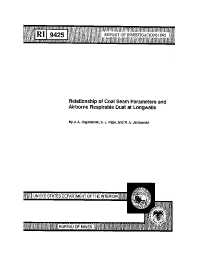Mining Publication: Relationship of Coal Seam Parameters and Airborne Respirable Dust at Longwalls
Original creation date: January 1992
The U.S. Bureau of Mines investigated the relationship of bituminous coal seam parameters and the amount of airborne respirable dust generated at longwalls. Dust and coal samples were obtained from 20 longwalls operating in geographically representative coalfields throughout the United States. Statistical analyses of coal seam parameters and airborne respirable dust measurements indicate a likely causal relationship between seam type and respirable dust. Low-ash, high-volatile coal seams were associated with higher airborne respirable dust levels. A negative linear correlation (significant at the 95-pct confidence level) was observed between the seam's ash content and airborne respirable dust, explaining up to 18 pct (r2 = 0.18) of headgate dust level variation and up to 15 pct of tailgate dust level variation. Volatile matter was found to have a positive linear correlation with tailgate dust level, explaining 16 pct of the variation. Further data examination indicated that these relationships with dust are most likely nonlinear, because of improved r2 values over the linear correlations. However, a notable portion of longwall dust production is influenced by other operational parameters, so additional research under more controlled conditions is needed to determine the seam's causative functions.
Authors: JA Organiscak, SJ Page, RA Jankowski
Report of Investigations - January 1992
NIOSHTIC2 Number: 10011418
U.S. Department of the Interior, Bureau of Mines, Report of Investigations 9425, 1992 Jan:1-18
See Also
- Benchmarking Longwall Dust Control Technology and Practices
- Controlling Respirable Dust in Coal Mining Operations
- Dust Considerations When Using Belt Entry Air to Ventilate Work Areas
- The Effects of Water Spray Placement for Controlling Respirable Dust and Face Methane Concentrations
- Equivalency of a Personal Dust Monitor to the Current United States Coal Mine Respirable Dust Sampler
- Investigation of Coal Properties and Airborne Respirable Dust Generation
- Laboratory Evaluation of Pressure Differential-based Respirable Dust Detector Tube
- Laboratory Testing To Quantify Dust Entrainment During Shield Advance
- New Tools To Monitor Personal Exposure To Respirable Coal Mine Dust
- Performance of a Light Scattering Dust Monitor at Various Air Velocities: Results of Sampling in the Active Versus the Passive Mode
- Content source: National Institute for Occupational Safety and Health, Mining Program


 ShareCompartir
ShareCompartir
